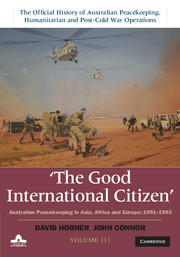Book contents
- Frontmatter
- Contents
- Maps
- Preface
- Chronology 1989–99
- Abbreviations
- Part 1 Strategy and policy
- Part 2 Cambodia
- 3 From Angkor Wat to Pol Pot
- 4 Law and order on the border
- 5 An Australian peace proposal
- 6 First into Phnom Penh
- 7 The roadblock
- 8 Change in plan
- 9 ‘Democracy's surprise triumph’
- 10 Developing Operation Banner
- 11 Winding up Operation Banner
- Part 3 Western Sahara
- Part 4 Former Yugoslavia
- Part 5 Watch on Iraq
- Appendix A United Nations Security Council resolutions
- Appendix B Major office bearers, 1991–99
- Bibliography
- Index
- Plate section
- References
7 - The roadblock
Australians in the UN Transitional Authority in Cambodia, February–May 1992
from Part 2 - Cambodia
Published online by Cambridge University Press: 12 May 2022
- Frontmatter
- Contents
- Maps
- Preface
- Chronology 1989–99
- Abbreviations
- Part 1 Strategy and policy
- Part 2 Cambodia
- 3 From Angkor Wat to Pol Pot
- 4 Law and order on the border
- 5 An Australian peace proposal
- 6 First into Phnom Penh
- 7 The roadblock
- 8 Change in plan
- 9 ‘Democracy's surprise triumph’
- 10 Developing Operation Banner
- 11 Winding up Operation Banner
- Part 3 Western Sahara
- Part 4 Former Yugoslavia
- Part 5 Watch on Iraq
- Appendix A United Nations Security Council resolutions
- Appendix B Major office bearers, 1991–99
- Bibliography
- Index
- Plate section
- References
Summary
On 16 March 1992 foreign troops paraded in the streets of Phnom Penh. Over the previous five centuries, Cambodia had been invaded or occupied by Thai, Vietnamese, French, Japanese and US armies, but the soldiers marching through the capital on this day were different. These men of the Indonesian 503rd Infantry Battalion came not as warriors to wage war on the Cambodian people, but as peacekeepers who would help implement the Paris Peace Agreement. The parade was reviewed by Prince Sihanouk, the former king and current chairman of the Supreme National Council representing the four Cambodian factions that had signed the peace agreement. At Sihanouk's side were two men. The first was Yasushi Akashi, the Japanese UN official who would lead the UN Transitional Authority in Cambodia (Untac). The second was Lieutenant General John Sanderson, the Australian Army officer appointed to command Untac's Military Component. The arrival in Phnom Penh of Akashi, Sanderson and the Indonesian battalion on 15 March 1992 marked the end of the small UN Advance Mission in Cambodia (Unamic), whose role had been to assist the Cambodian factions maintain their fragile ceasefire, and heralded the beginning of Untac, the much larger mission with unprecedented powers to implement the peace plan and organise the election that would create the country's new government.
- Type
- Chapter
- Information
- The Good International CitizenAustralian Peacekeeping in Asia, Africa and Europe 1991–1993, pp. 138 - 168Publisher: Cambridge University PressPrint publication year: 2014

